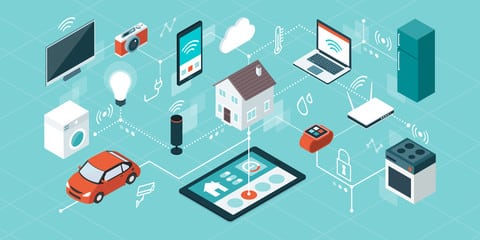Creating Smarter Infrastructure and Enhancing Public Sector Services, Liveability and Safety through IoT

Hear from
Geoff Cooper
, the
General Manager
for
Strategy
at
Infrastructure Commission
as he discusses about long-lived infrastructure in the face of rapid technological change (New Zealand’s 30-year Infrastructure Strategy)
The tension between technology and infrastructure

In many ways, infrastructure is at the heart of every society. All of us live in houses or apartments, and use water and roads, all of which are part of the infrastructure of society. Many of these have been around for years, yet at the same time, we also live in a society full of technology, where there is a constant thirst for the latest gadget or software. Geoff Cooper , the General Manager of Strategy at New Zealand’s Infrastructure Commission, says that “this tension in adaptation is at the absolute heart” of what the Commission currently faces. This is especially the case because the Commission has “a very broad remit” in terms of how they define infrastructure. In simple terms, they define infrastructure as “moving things, particularly resources, around communities, regions, countries, or the world.” Therefore the energy, water, transport, education and telecommunications sectors are all part of what is broadly seen as the infrastructure sector. “At the end of the day, infrastructure is designed to provide services that help us live, work and play where and when we want to.”
Some sectors are really good at providing services, whilst others are less good. Overall, New Zealand is “ranked 46 th in the world by the World Economic Forum, so not all that good by international benchmarks” This is largely due to a number of factors including immigration, community expectations, climate change mitigation, asset management and flexibility, and of course rising costs. Most countries have similar challenges but some of these got away from New Zealand and in fact, that is why the Infrastructure Commission was established in 2019. “Our goal is to really think about how to close that gap between the system and services that we currently have now and for the future, and the enormous infrastructure and technological challenges that we face.” To that end, the Commission recently published ‘Infrastructure for a Better Future’, “a consultation document to inform the draft New Zealand Infrastructure Strategy, which will go to the Minister in September.”
Essentially the document and the plan have “five priority areas: institutions and governance; infrastructure funding and pricing; housing affordability and supply; climate change, resilience and the environment; and technology change and our digital future.” Although technology is listed separately, in many ways it “runs across all of the priorities, and adapting to technology is essential to lowering costs, improving services and improving infrastructure delivery.” The problem however – which in some ways is a good problem to have – is that “we’re laying down assets that have very long lifespans.” Some are “more than generational, like some of our water or transportation assets that have been around for 100 or more years.” They last for a very long time but are not very adaptable to change.
Using technology to enhance existing infrastructure

In many ways, those who build infrastructure are constantly thinking about the future, “30 years in advance.” In reality though, most of the 2050 infrastructure “is already around us.” According to the UK Infrastructure Commission, “we are only adding 1% to the stock of infrastructure in any given year.” Sure, that adds up, but in the UK they also say that “our future welfare and livelihoods depend increasingly on the less glamorous work of improving our existing infrastructure.” This is where technology can add greater value. Since 99% of the infrastructure is existing stock, it should be leveraged. For example, technology has been identified as having a “substantial impact” across all infrastructure sectors. A recent NZ Infrastructure Commission report has even codified the ways in which “key smart technologies” can be used in conjunction with existing infrastructure. These include:
- 67 IoT – “for sensors, data collection and performance information”
- Digital twins – “for asset lifecycle optimisation”
- Immersive media – “including AR/VR, for services at a distance”
- Cybersecurity – “for data ownership and privacy”
There is currently a proposal for national digital twins, whilst some of the barriers to establishing these technologies include “cost, the business case, standardisation, regulatory and legal frameworks, and security around open data and cloud storage.” However, trying to overcome these barriers is critical because it is likely to result in significant gains. For instance:
- Decision-making – “With real-time, accurate and comprehensive open data, asset managers can make better decisions using data analysis.”
- Flexibility – “Using technologies like robotics or AI, infrastructure can be better managed and operated with a higher level of flexibility. For instance, in Melbourne this is currently being trialled for better traffic management and routing through the use of real-time traffic data.”
- Revenue and cost optimisation – “Using data to make better pricing decisions and enhance the profitability or use of an asset. This can be applied to congestion or parking costs, for example.”
- Sustainability – “An ability to track the carbon footprint of an asset, and to provide assurances to financiers for the environmental impact goals – to get to net zero carbon.”
- Customer centricity – “To improve infrastructure service delivery by using the information from the customer to better prioritise things like maintenance and renewals of assets. For instance, Sydney Water is using social media channels for feedback to assist with prioritisation.”
The goal obviously, is to strike a balance between existing infrastructure and emerging technology. These five likely gains, along with the five smart technologies can only come together if there is a supportive structure or “backbone” sitting behind them. In this case, the Infrastructure Commission has identified some of the supports that are required to ensure that the gains can be realised. For instance, most of the technologies rely on data, and particularly open data. So the data needs to be “accessible and standardised.” Some sectors or countries don’t have data strategies and this will work against them in the long-run. “There is even a case to be made for data as an infrastructure – digital data. We need to think about governance, interoperability and trust when it comes to data.”
Communication is also a necessary support, especially as 4G and 5G networks are being rolled out. There are “unprecedented leaps in these technologies that need to be leveraged.” Security also needs to be considered, especially as it relates to “data ownership and sovereignty, as well as governance, privacy and resilience. We need to bring the public along the way with us.” But none of this can be achieved without appropriate skills and capabilities. Technology is changing fast and the people involved need to keep up.




















